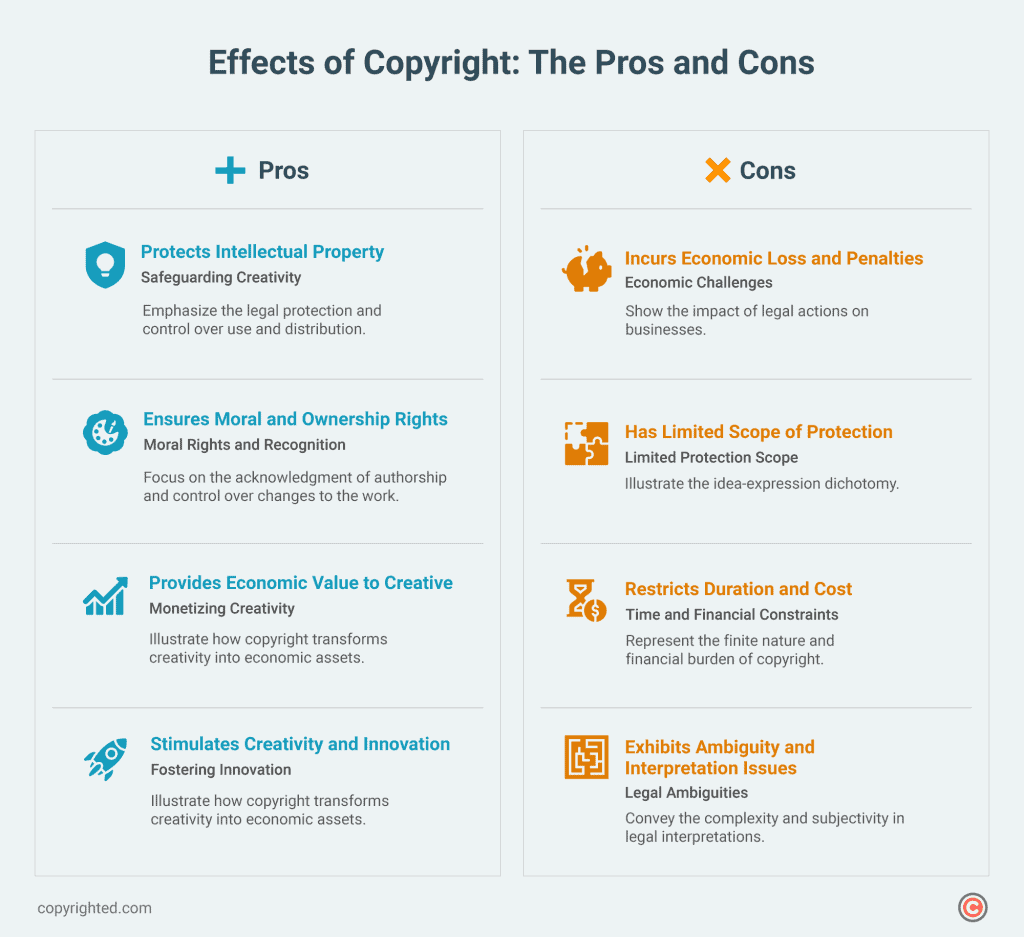As copyright continues to play a critical role in the digital age, it’s essential to understand how it affects creators in multiple aspects.
The essence of copyright lies in recognizing and securing original works. While functioning as an important tool for protection, copyright is not without drawbacks.
In this article, we’ll discuss the effects of copyright, dissecting both its positive aspects and possible challenges for creators and businesses.
- The main goal of copyright is to acknowledge and protect the unique ideas, expressions, and original works created by individuals or groups.
- Copyright, while serving as an essential tool for protection, comes with its set of drawbacks.
- Copyright is not perpetual and comes with limitations on its duration.
Effects of Copyright: The Pros and Cons You Need to Be Aware Of

While the primary purpose of copyright law is to protect intellectual property, copyright has both advocates and critics due to its far-reaching impact on various aspects of the creative process. In this discussion, we’ll explore the pros and cons of copyright, shedding light on its positive contributions and potential drawbacks.
PROS
Copyright is a vital component of intellectual property law. Now, let’s examine the positive aspects of copyright more closely.
1. Protects Intellectual Property
Copyright establishes a structured and legal framework to shield creative works from unauthorized use.
In this system, it ensures that the copyright owner receives proper credit and payment for their innovative works. Hence, it discourages unauthorized use, copying, distribution, and public display of their creations.
The main goal of copyright is to acknowledge and safeguard the unique ideas, expressions, and original works created by individuals or groups. This protection allows creators to control how their intellectual property is used, deciding how it’s shared and commercialized in an organized manner.
2. Ensures Moral and Ownership Rights
Copyright grants creators not only economic rights but also moral rights, acknowledging their connection to their work.
Creators gain more than money — they receive recognition as the authors of their work and the power to object to any changes that could harm their reputation. Being acknowledged as the author and having control over how the work is used boosts the creator’s pride and sense of responsibility.
3. Provides Economic Value to Creative Works
Copyright serves as a mechanism for identifying and securing the economic value of creative works. It allows creators to monetize their efforts by controlling the reproduction, distribution, and public display of their work, thereby creating a market for their intellectual creations.
This framework enables creators to negotiate licenses, sell rights, and establish partnerships, contributing to the overall economic worth of their creative endeavors.
4. Stimulates Creativity and Innovation
Despite its constraints, copyright law serves as a catalyst for creativity and innovation within a legal framework. By offering creators exclusive rights, copyright provides an incentive so creators and businesses can invest time, resources, and talent in developing new and original content.
The promise of protection and potential earnings encourages creators to explore new ideas without worrying about immediate copying. Knowing that their work will be legally recognized and protected from unauthorized use, creators feel inspired to push their creative boundaries and contribute to the growth of different creative industries.
While copyright imposes restrictions on how protected works can be used, these limitations also prompt creators to find unique ways to express their ideas within legal boundaries. This balance between protection and limitations creates a dynamic environment where creativity thrives, and fresh ideas constantly emerge, advancing artistic and intellectual progress.
CONS
Copyright, while serving as an essential tool for protection, comes with its set of drawbacks. Let’s delve into a detailed discussion about these disadvantages.
1. Incurs Economic Loss and Penalties
Copyright and intellectual property violations lead to economic losses for U.S. businesses. When businesses use copyrighted material without permission, they can face legal actions that result in financial penalties and damages.
Copyright infringement affects the economy by contributing to an overall economic loss within the United States. The costs associated with copyright infringement cases, including legal fees and potential settlements, can be significant and pose a threat to the economic well-being of businesses involved in such violations.
2. Has Limited Scope of Protection
Copyright protection is limited to the expression of ideas, not the ideas themselves. This means that while it guards how creative concepts are presented, the underlying ideas are not secured.
This limitation can potentially neglect other forms of protection needed for broader aspects of innovation, leaving certain elements vulnerable to unauthorized use or replication. When the core idea is more abstract or conceptual, copyright may fall short of providing comprehensive protection, highlighting the need for additional legal protection beyond copyright.
3. Restricts Duration and Cost
Copyright protection, while valuable, is not perpetual and comes with limitations on its duration. The finite nature of copyright means that the exclusive rights granted to creators have a predetermined timeframe, after which the work enters the public domain.
This limited duration may pose challenges for creators and businesses aiming to secure long-term economic returns from their intellectual investments. Determining the duration of copyright protection involves the lifespan of the creator plus certain years after the author’s death.
Moreover, the costs associated with copyright add another layer of challenge. Registering, maintaining, and enforcing copyright can be financially burdensome, particularly for individual creators or small businesses with limited resources.
This economic aspect and the finite duration may make it more challenging for certain creators to access and maintain legal protection for their creative works.
4. Exhibits Ambiguity and Interpretation Issues
The U.S. copyright law, particularly in areas like the fair use doctrine and distinguishing derivative works, is susceptible to ambiguity, giving potential challenges in interpretation.
The fair use doctrine, which permits limited use of copyrighted material without permission, is subjective and depends on factors like purpose, nature, amount, and effect. This subjectivity can lead to different interpretations, paving the way for potentially lengthy and costly legal battles.
The distinction between what constitutes a derivative work and a creation based on an existing copyrighted work is another area prone to ambiguity. Determining the line between transformative creation and infringement can be subjective, often resulting in legal disputes that may be complex and time-consuming.
This ambiguity in U.S. copyright law introduces uncertainties that can have real-world implications for creators, users, and businesses. The potential for legal battles can be financially burdensome and may deter some from engaging in creative activities, limiting the free flow of ideas and expression.
Frequently Asked Questions
How does copyright infringement affect the economy?
Copyright infringement can lead to economic losses by impacting industries and businesses that rely on intellectual property. It may result in decreased revenue for creators and legal expenses for those enforcing their rights.
How does copyrights affect a business?
Copyright allows businesses to protect their creative works, encouraging innovation and ensuring a competitive edge. However, infringement risks, legal costs, and the need for compliance can pose challenges.
What are the risks of copyright?
Risks include potential infringement lawsuits, financial penalties, and reputational damage for unauthorized use of copyrighted material. Businesses may also face challenges navigating complex copyright laws.
Does copyright affect creativity?
Copyright, while protecting creators, can also influence creativity. While it provides incentives and protection, some argue that it may impose constraints on certain forms of expression, potentially impacting creative freedom.
What is the impact of copyright?
Copyright has a dual impact by protecting intellectual property, encouraging innovation, and providing economic benefits. However, it also presents challenges, including legal complexities, potential limitations on creative freedom, and the need for businesses to navigate compliance and risks.


